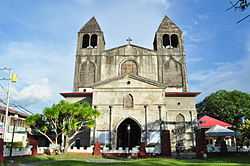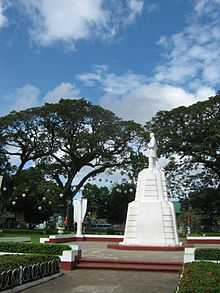Dapitan
| Dapitan | |
|---|---|
| Component City | |
 | |
 | |
.svg.png) Dapitan | |
| Coordinates: 08°39′N 123°25′E / 8.650°N 123.417°ECoordinates: 08°39′N 123°25′E / 8.650°N 123.417°E | |
| Country |
|
| Region | Zamboanga Peninsula (Region IX) |
| Province | Zamboanga del Norte |
| District | 1st District, Zamboanga del Norte |
| Barangays | 50 |
| Government[1] | |
| • Mayor | Rosalina G. Jalosjos |
| Area | |
| • Total | 390.53 km2 (150.78 sq mi) |
| Population (2010) | |
| • Total | 33,729 |
| • Density | 86/km2 (220/sq mi) |
| Time zone | PST (UTC+8) |
| ZIP code | 7101 |
| Dialing code | 65 |
| Income class | 3rd |
| Website | www.dapitancity.gov.ph |

The City of Dapitan (Subanen: Gembagel G'benwa Dapitan/Bagbenwa Dapitan, Cebuano: Dakbayan sa Dapitan, Spanish/Chavacano: Ciudad de Dapitan) is a 3rd class city in the province of Zamboanga del Norte, Philippines. According to the 2010 census, it has a population of 77,441 inhabitants. It is historically significant as being the place where the national hero, Jose Rizal was exiled by the Spaniards and is known as the "Shrine City in the Philippines." The city also boasts of Fantasyland, the first amusement park in the Visayas-Mindanao region.
History
The beginnings of the settlement now known as the city of Dapitan predates the arrival of the Spanish conquistadores on the island of Mindanao. The Subanens, a nomadic tribe of Indo-Malayan stock, were the earliest known settlers who lived along river banks or "suba", from which word they received their present tribal identity as Subanen. However, it is believed that the timid Subanens were forced to move further into the hinterlands of the Zamboanga peninsula out of fear that pirates may seek shelter during foul weather in the natural harbors of Dapitan’s irregular coastlines. They are now mainly found in the mountainous areas of Zamboanga del Sur and Misamis Occidental.
Early cartographers of the Philippines showed Dapitan’s location in their maps of Mindanao using a variety of names by which they had known the settlement, such as “Dapito” in Kaerius’ map of 1598, “Dapite” in Dudley’s map of 1646, “Dapyto” in Sanson’s map of 1652, and “Dapitan” in Moll’s map of the East Indies of 1729 and in Murillo Velarde’s map of 1734.
There are two versions of how Dapitan got its name. The first, from an account attributed to Fr. Urdaneta, infers that the name evolved from the original reference to it as "Daquepitan", which later became "Dacpitan" and finally "Dapitan" to make it easier to pronounce.
The second version, which is more widely accepted according to folklore, says that the name derives from the Cebuano word “Dapit”, which means “to invite”. Local tradition tells of the early settlers from Panglao in Bohol who were invited over by Datu Pagbuaya, the acknowledged founder of Dapitan, to join him in "Dakung Yuta", or literally the big land that is Mindanao. The invitation or pag-dapit that he extended to Boholanos is said to be how Dapitan got its name.
Various historical accounts also indicate that trading voyages and commercial relations existed with the nascent but thriving settlement of Dapitan. This interaction with traders from the different cultures in the region may have had some influence on the cultural evolution of Dapitan itself. The influence of the Spaniards, the Americans, the Japanese, and the different Visayan ethnolinguistic groups that settled here could not also be discounted in their contributions toward the evolution and emergence of a distinctly Dapitanon culture.
Cityhood
On June 22, 1963, President Diosdado Macapagal signed R.A. 3811 which converted Dapitan into a chartered city. It is officially renowned as the “Shrine City of the Philippines.”
The earliest settlers of Dapitan were the Subanens, a nomadic tribe of Indonesian stock known to have settled and lived along the banks of the river or “suba” out of which their present day tribal identity originated.
Barangays
Dapitan City is politically subdivided into 50 barangays. In 1955, the sitios of Sipalok, Barcelona, and Potungan were converted into barrios.[2]
- Aliguay
- Antipolo
- Aseniero
- Ba-ao
- Bagting (Pob.)
- Banbanan
- Banonong (Pob.)
- Barcelona
- Baylimango
- Burgos
- Canlucani
- Carang
- Cawa-cawa (Pob.)
- Dampalan
- Daro
- Dawo (Pob.)
- Diwa-an
- Guimputlan
- Hilltop
- Ilaya
- Kauswagan
- Larayan
- Linabo (Pob.)
- Liyang
- Maria Cristina
- Maria Uray
- Masidlakon
- Napo
- Opao
- Oro
- Owaon
- Oyan
- Polo
- Potol (Pob.)
- Potungan
- San Francisco
- San Nicolas
- San Pedro
- San Vicente
- Santa Cruz (Pob.)
- Santo Niño
- Sicayab Bocana
- Sigayan
- Silinog
- Sinonoc
- Sulangon
- Tag-olo
- Taguilon
- Talisay (Pob.)
- Tamion
Taguilon
Taguilon is home to the Dakak Park and Beach Resort. It is a producer of coconut and agar (based on sea weed) as well as a fishing port. The pier in Taguilon is a secondary/alternate port to the main passenger/cargo port in Dapitan City. Additionally, during severe storms at sea, ferries and other ships find shelter in the Taguilon cove. One can find the mount Lalab overlooking the islets of Silinog and part of Balyangaw.
Festivals
Dapitan City has launched a diversified fiesta celebration of its Patron St. James or Señor Santiago for the locals through a three-in-one affair, combining religious, cultural and sports events in its Kinabayo Festival 2009.
The Kinabayo Festival kicks off July 16 and culminates on July 31 with various events taking place within the Shrine City of the Philippines.
Book on Rizal's Letters

On December 28, 2007, as highlight of Dapitan City's 2nd Handuraw Festival, former Congressman Romeo Jalosjos launched at the Jose Rizal Memorial State College his book "The Dapitan Correspondence of Dr. Jose Rizal and Dr. Ferdinand Blumentrit", a compilation on letters of the Dr. Jose Rizal, and his friend Dr. Ferdinand Blumentrit.[3]
International relations
Twin towns — Sister cities
Dapitan is twinned with:
 Litoměřice, Czech Republic
Litoměřice, Czech Republic Zamboanga City, Philippines
Zamboanga City, Philippines
References
- ↑ "Official City/Municipal 2013 Election Results". Intramuros, Manila, Philippines: Commission on Elections (COMELEC). 1 July 2013. Retrieved 5 September 2013.
- ↑ "An Act Converting into Barrios Certain Sitios in the Province of Zamboanga Del Norte". LawPH.com. Retrieved 2011-04-11.
- ↑ GMA NEWS.TV, Jalosjos book on Rizal launched in Dapitan
External links
| Wikimedia Commons has media related to Dapitan. |
